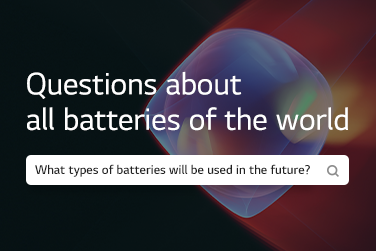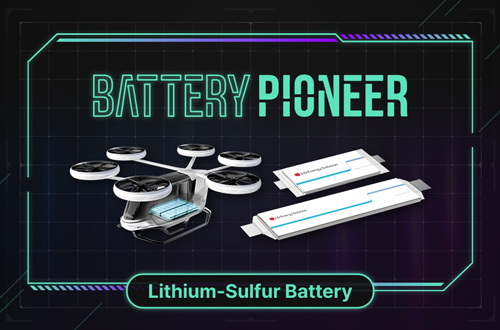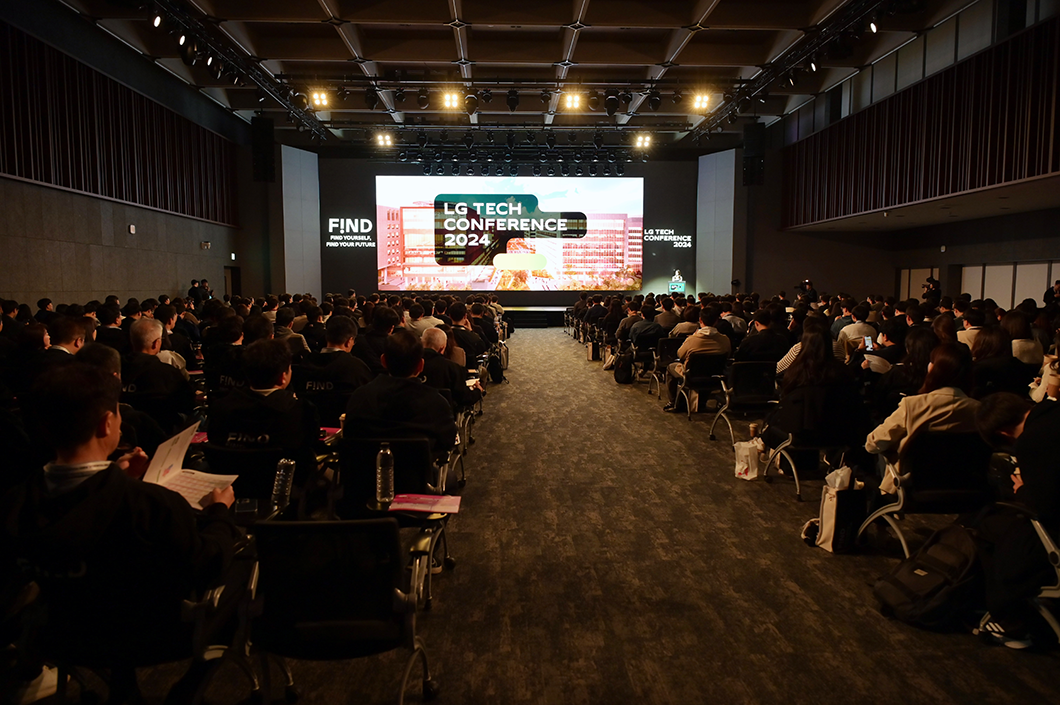
The importance of cylindrical batteries is only growing because they are used widely from small electronic devices to EVs. In line with the trend, LG Energy Solution has continued researching and developing cylindrical batteries to improve their capacity and performance.
At the “LGES Cylindrical Li-ion Batteries in The Era of E-mobility” session of LG Tech Conference 2024 hosted at LG Sciencepark in Gangseo-gu, Seoul on April 4, there was a presentation on the history and technology trend of cylindrical batteries. The speech delivered information on cylindrical batteries currently being developed by LG Energy Solution. Here’s what Kwan-soo Lee working at the Small Battery Development Center has to say.
LG Energy Solution’s Cylindrical Batteries, from 1865 and 2170 to 46-Series
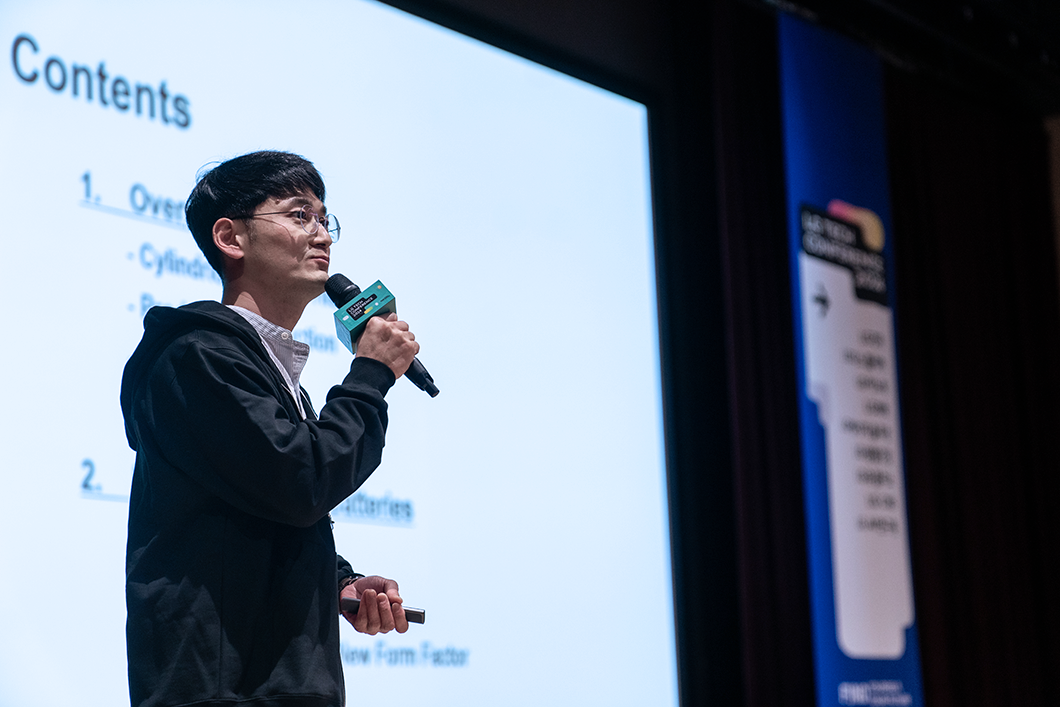
LG Energy Solution began its research on lithium-ion batteries in 1992. It launched the development of lithium-ion batteries in 1996 and entered into the battery market with the first mass-production of laptop batteries in 1999.
Batteries have been adopted for a variety of applications ever since. We developed the 1865 cylindrical battery to provide to manufacturers of electric scooters and power tools in 2006 and broadened the application of these batteries in earnest, putting them in LEVs* and then high-performance EVs from 2016.
We produced the 2170 battery, an improvement in capacity and efficiency of the 1865 battery and adopted it for Energy Storage System(ESS)s in 2019. We then upgraded it to show better performance and have higher safety, starting the supply of the improved version to leading North American EV manufacturers in 2020.
LG Energy Solution has increased the battery sizes and is currently developing the 46-series battery. The 46-series offers 46 mm in diameter and a wide range of height (80 mm – 120 mm), further expanding the application of cylindrical batteries.
* LEV: Light Electric Vehicles. They include electric bikes, scooters, and wheelchairs.
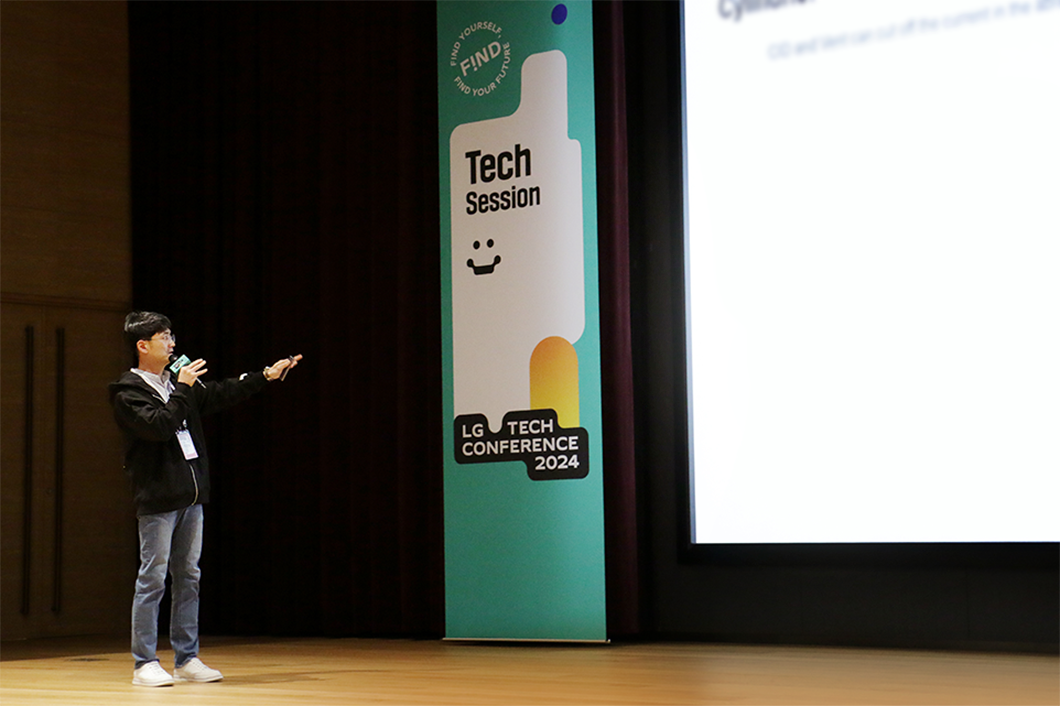
A cylindrical battery has a mechanically stable “thick can” structure, meaning it is basically very safe. This feature allows the application of various and most advanced materials to it ahead of other types of batteries.
These batteries are widely used for devices that require a sudden high output such as power tools as well as LEVs and EVs due to their high energy density and capacity. They can be used for various applications easily and quickly as they come in standardized sizes such as 1865 and 2170.
Once, cylindrical batteries were mostly used for electronic devices such as laptops, but some raised questions about their future as electronic devices became slimmer. However, their advantages mentioned earlier put them in LEVs and brought about the expansion of their boundaries into the mobility market. Now, leading EV makers and startups in North America as well as automakers in Europe pay attention to cylindrical batteries, and many global finished car manufacturers are considering adopting them for their EVs, having noticed the potential.
Such moves led to the enlargement of the EV market powered by cylindrical batteries. The prospect for the cylindrical battery market is also promising. The annual growth rate from 2024 to 2028 is expected to be approximately 41%, with the EVs accounting for the largest share of the cylindrical battery market.
46-Series Batteries, Cylindrical Batteries with Many Advantages
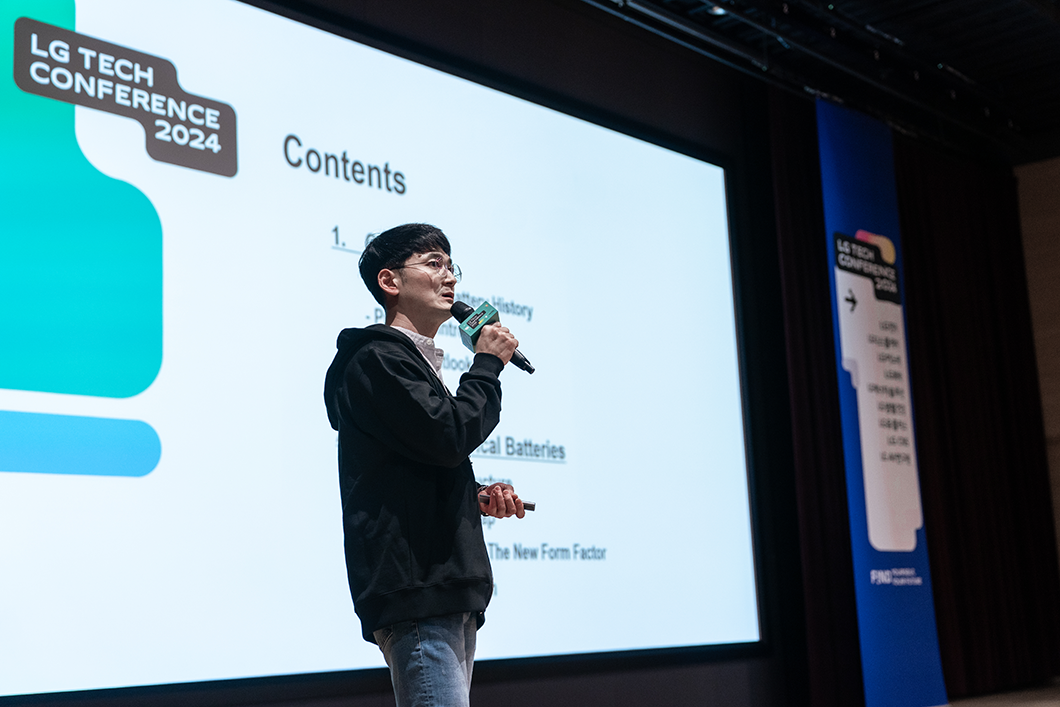
Management of Safety and Thermal Propagation
As mentioned earlier, a cylindrical battery is encased by a hard can and can be vented at a “unit battery” level. This structure allows it to not only maintain a stable shape even after repeated charging and discharging at normal times, but also secure safety when it is exposed to abnormal circumstances such as an internal gas leak or abrupt chemical reaction during charging or discharging.
One of the most common protection tools embedded inside a cylindrical battery is the Current Interrupt Device (CID). When internal gas is created during charging or discharging and puts pressure above a certain level, CID cuts off the electrical circuit and turns it into an open circuit. Also, the vent keeps the battery safe by releasing the gas safely out of the battery.
Safety deserves the highest priority in a battery system. An EV especially needs a device that can prevent chain ignition that can be sparked by thermal propagation, because it has a large amount of battery cells inside. A battery pack of an EV contains from hundreds to thousands of battery cells. If one cell is on flame, the heat might spread to those next to it. Therefore, a large battery system needs a technological approach to effectively manage thermal propagation.
The safety of cylindrical batteries has been proven through many tests. For example, the cell’s side remained without a rupture after the cell had been exposed to high temperature and ignited in a heater test. Also, the cell remained stable without causing a chain ignition through thermal propagation to adjacent cells when the center cell ignited in a honeycomb structure of the cells. To make that possible, the mechanical properties of the can was enhanced and the venting system was optimized.
Significance and Goals of Cylindrical Battery Development
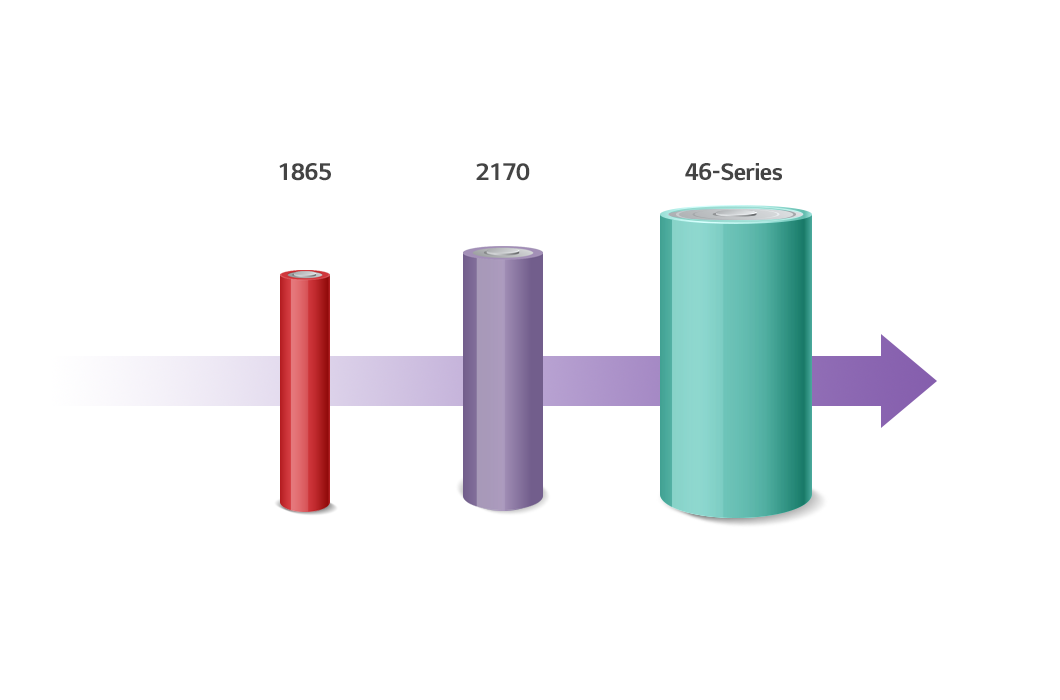
LG Energy Solution is currently developing the 46-series, a line larger than the 1865 and 2170 batteries. The 46-series cylindrical battery offers more energy, as it can hold more active materials. In particular, nickel content is being increased for higher density and battery capacity.
The 46-series has a simpler pack structure and lower cell counts, but still can provide customers with higher energy efficiency. For example, approximately 4400 cells with the size of the 2170 batteries can be replaced by only 828 cells with the size of the 4680 batteries. As such, the 46-series contributes to a reduction in manufacturing costs and time while improving efficiency of the overall battery system.
As in the case of the 46-series, a change in size and accompanying importance of mechanical structure are emphasized. Structural design and development of a battery from the perspective of mechanical engineering are essential for battery performance and safety. The importance can be compared to that of material composition.
Development of the 46-series is not just about growth in size but can be considered an important step in the path to opening a new chapter of cylindrical battery technology as well as a preparation to meet the rising demand for cylindrical batteries.
Advantages of 46-Series Cylindrical Battery

All eyes of global finished car manufacturers and battery makers are on the 46-series, the new standard of cylindrical batteries. In response, LG Energy Solution is proactively preparing mass-production of the 46-series battery cells.
The 46-series can resolve major disadvantages of its predecessors. The 1865 and 2170 cylindrical batteries need tabs that work as paths for currents to flow to certain spots in a jelly-roll structure where the electrodes are rolled up. And the electrodes can be deployed efficiently with the employment of various designs. But the design accompanies a rise in resistance. In comparison, the 46-series has the advantages of pouch-type batteries and the 2170 cylindrical batteries and is being developed to lower resistance as it is designed to maintain the same energy density with an improvement in current flow. Also, the “directional venting,” a technology that is applied at the unit cell level, which also is an advantage of cylindrical batteries, is employed. This technology rapidly releases the implosion energy of a battery out of it, reducing the cell’s resistance and securing the cell’s safety, and preventing chain ignition at the same time.
A transition to the 46-series could lead to cost savings by expanding production scale. The economic benefits are larger as that allows production of cells with 5 times higher energy capacity within the same time frame as well as more energy on the same production lines. A cut in manufacturing costs can be crucial for customers as well because it raises the possibility for EVs to penetrate into the entire car market. The 46-series can produce even more energy because it speeds up the electrode production line by about 1.5 times while allowing the assembly line to keep its takt time.
For the previously invented cylindrical batteries, slurries were coated onto electrodes at the rate of 40 meters per minute with the intermittent coating method. Periodical discharge and stoppage of slurries in this process created patterns and the electrodes with the patterns on them were wound to make a component. In comparison, for the 46-series, the “zebra coating” method was applied. Since this method proceeds with coating continuously without stoppage, the safety and efficiency in producing electrodes are higher.
* Takt time: The time needed to complete a product.
LG Energy Solution’s Technology Producing High-performance Batteries
There are many things to consider from the customers’ perspective in developing EV batteries. A battery’s energy is directly related to driving distance while different materials and designs have an impact on quick charge. To increase energy capacity, high-capacity materials that have a high nickel content such as silicon-based anode are essential. As for the quick charge, it can impact the long-term life and durability of the battery, although it offers convenience to drivers. Therefore, research on the optimum formulation and stability of cathode and anode active materials is necessary.
Since safety and reliability have to be secured first and foremost, it is important to improve thermal and physical safety of a separator and find the right materials and combination of electrolyte that prevents low voltage and plays an important role in enhancing performance and safety.
Cathode
LG Energy Solution uses NCM-based cathode materials that allow high-capacity energy storage. We became the world’s first to mass-produce batteries consisting of NCM 523 cathode materials for electronic devices in 2007 and have been producing batteries consisting of NCMA cathode materials with a nickel content of at least 85% since then. The most important thing to consider in producing high-capacity high-nickel batteries is “How stably the energy is provided.” Structural safety and surface safety have to be secured through effective doping and coating. We have studied relevant materials as well as surface coating and multi-doping techniques for the purpose.
Also, we reinitiated research on single-crystal cathode materials. These materials do not create a crack as they have a higher stress resistance compared to poly-crystal cathode materials and are less likely to produce internal gas.
Anode
Silicon-based anode materials are often used for high-capacity NCMA batteries and offer high energy density, but the volume might expand during charging, which requires adequate control. That’s why research on conductive additives, which will be applied with anode materials, is ongoing in addition to research on silicon anode material itself. These methods include minimizing expansion by adding other materials to silicon or increasing stability by coating the surface of silicon particles.
Separator
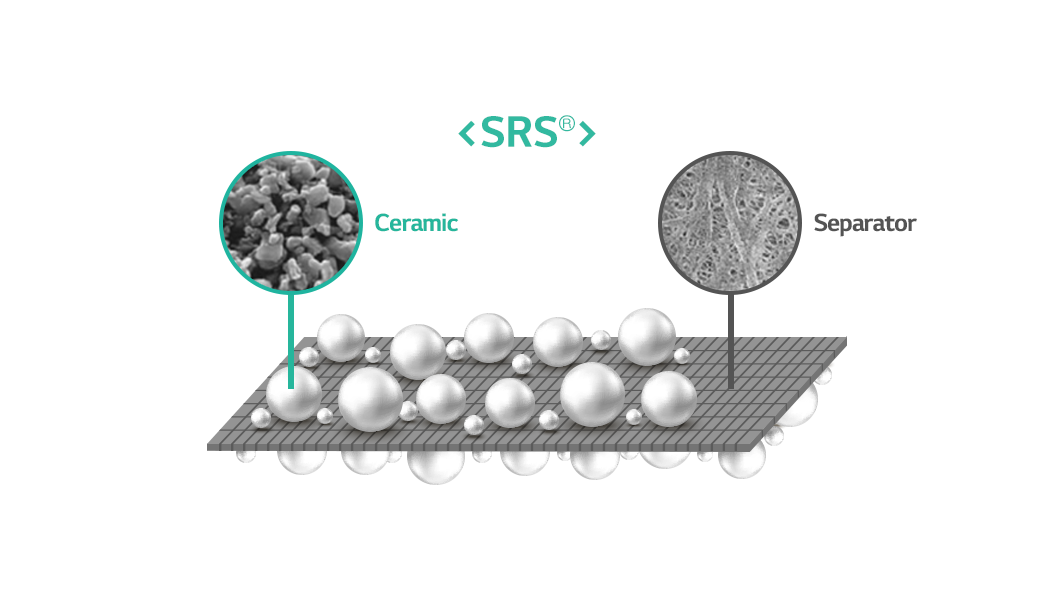
A separator keeps the cathode and anode apart, playing a crucial role in preventing a circuit. LG Energy Solution succeeded in mass-production of Safety Reinforced Separator (SRS®), a ceramic-coated separator with enhanced safety, for the first time in the world in 2004. This is a technology of applying ceramic coating and polymer binder onto the surface of the separator and it enhances heat resistance of a separator. Diverse ways are being researched on separators, a necessary effort for higher safety and performance of batteries.
Electrolyte
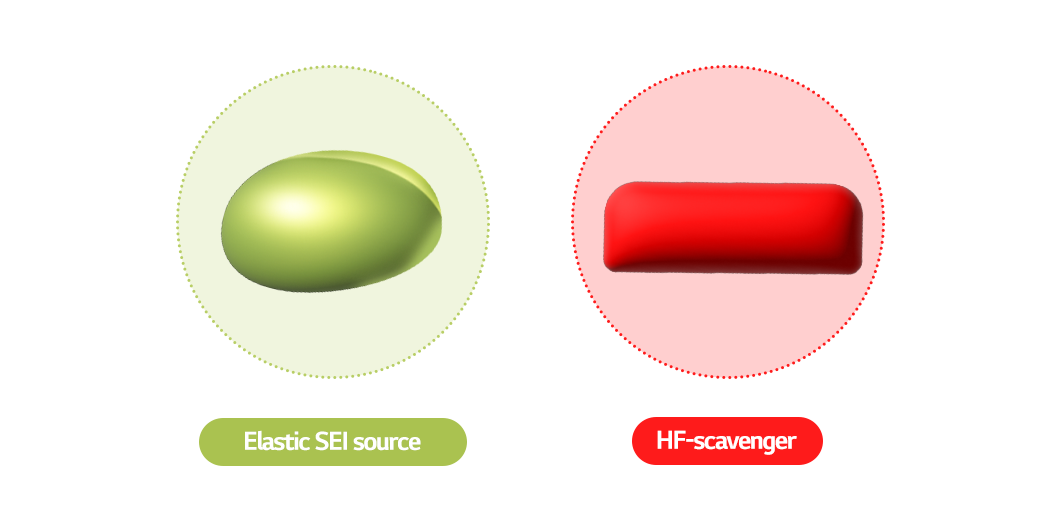
An electrolyte determines a battery’s voltage and performance. In particular, hydrogen fluoride(HF) scavengers and Elastic Solid Electrolyte Interface(SEI)s are important in resolving the increase in resistance in Hi-nickel cathode materials and instability of the SEI layer in silicon-based anode materials. HF scavengers neutralize hydrogen fluoride, preventing damage to the internal components while Elastic SEIs protect the newly created surface following the expansion of silicon anode materials, stabilizing the SEI layer.
These additives repress resistance even at about 60℃ and have a lower resistance value with time compared to previously developed electrolytes, contributing to improvement of battery safety and performance.

A leader in battery technology development, LG Energy Solution plans to mass-produce 46-series batteries at Ochang Energy Plant. With higher energy density and output, the next-generation cylindrical battery is expected to drive popularity of electricity-powered vehicles!
